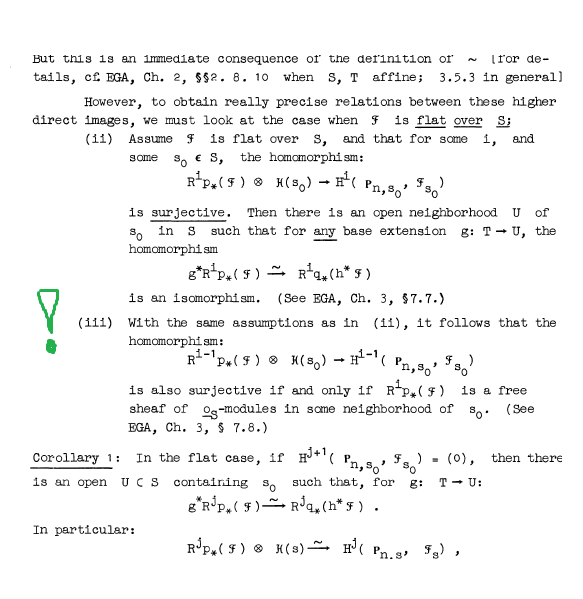I'm reading Mumfords's Lectures on Curves on an Algebraic Surface (jstor-link: https://www.jstor.org/stable/j.ctt1b9x2g3) and I found in Lecture 7 (RESUME OF THE COHOMOLOGY OF COHERENT SHEAVES ON $\mathbb{P}^n$; p 47) dealing with yoga on coherent sheaves $F$ over pojective space $\mathbb{P}^n$ I found on page 52 a proof I not understand:
Corollary 3: Given a coherent sheaf $\mathcal{F}$ on $\mathbb{P}^n \times S$, $\mathcal{F}$ is flat over $S$ if and only if there exists an $m_0$ such that if $m \ge m_0$, $p_* \mathcal{F}(m)$ is locally free. Hence, in this case, the Hilbert polynomial of on $\mathbb{P}^n _s$ is locally constant.
Proof: If $F$ is flat over $S$, then let $m_0$ be large enough so that derived image $R^i p_*(\mathcal{F}(m))=(0)$, if $i>0, m \ge m_0$. Using Corollary $1$ and $1 \frac{1}{2}$ one deduces that $p_*(\mathcal{F}(m)) \otimes k(s)$ maps onto $H^0(\mathbb{P}^n _s, \mathcal{F}_s(m))$ for all $s\in S, m \ge m_0$. Then by (iii), $p_* \mathcal{F}(m)$ is locally free. As for converse [...]
In original:
Problem: The "...Then by (iii), $p_* \mathcal{F}(m)$ is locally free..." part I not understand. (iii) (on page 51) states:
By above we know $p_*(\mathcal{F}(m)) \otimes k(s) \to H^0(\mathbb{P}^n _s, \mathcal{F}_s(m))$ is surjective, that is we can apply (iii) to $i=1$ and deduce $R^1p_*(\mathcal{F}(m))$ is locally free sheaf. But Mumford claims this for $p_* \mathcal{F}(m)= R^0 p_* \mathcal{F}(m)$.
Is this an error in the proof or do I miss something?


